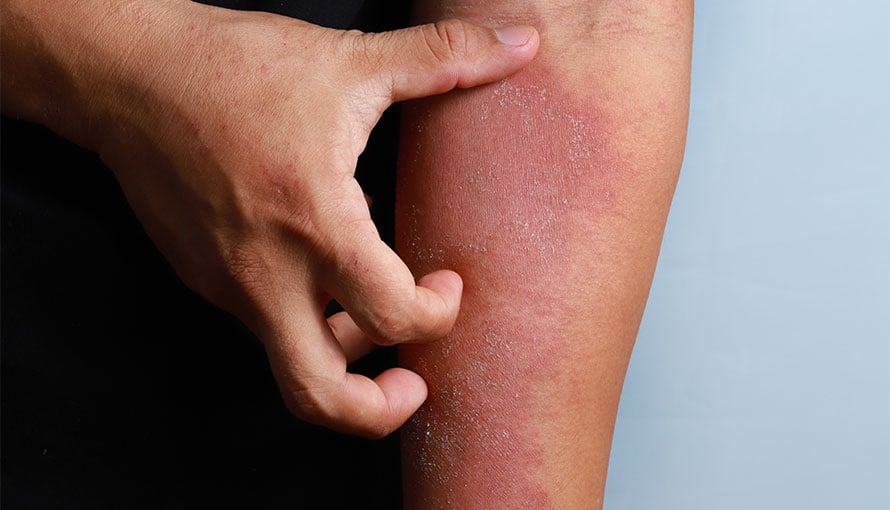Cutaneous T-Cell Lymphoma Symptoms

Cutaneous T-cell lymphoma is a form of non-Hodgkin lymphoma that affects the skin. The symptoms of cutaneous T-cell lymphoma (CTCL) can vary depending on its stage and what form of cutaneous T-cell lymphoma is present. For example, the disease’s two main subtypes—Mycosis Fungoides (MF) and Sezary Syndrome (SS)—have signs that differ slightly, although symptoms of both largely impact the skin.
The most common symptoms of Mycosis Fungoides include:
- Reddening of more than 80% of the skin (erythroderma)
- Thick, raised skin lesions that are often itchy (plaques)
- Red or discolored patches that may be flat and scaly
- Nodules or tumors beneath the skin
- Skin ulcers, sometimes with open sores
Sezary Syndrome is often associated with:
- Reddening of more than 80% of the skin (erythroderma)
- Swollen or tender lymph nodes
- Intense skin itchiness, often with large red rashes
- Frequently feeling cold due to the skin’s loss of temperature control
- Very thick and cracked skin on the hands or feet (keratoderma)
- Frequent staph infections
- Changes in eyelids, hair or nails
Other possible signs of cutaneous T-cell lymphoma include pimple-like lesions, hair loss, unexplained weight loss, fever and heavy sweating, especially at night. Specific symptoms can differ significantly from patient to patient, but most cases are associated with unusual changes in skin.
Promptly speak with a physician if any of these symptoms or other skin abnormalities develop. While most skin changes are not due to cutaneous T-cell lymphoma, it’s vital to rule out malignant causes and receive appropriate treatment before symptoms progress. As is the case with most all cancers, early detection of lymphomas leads to better outcomes and a positive quality of life.
Risk factors for cutaneous T-cell lymphoma
A risk factor is anything that can increase a person’s likelihood of being diagnosed with a particular disease. Established risk factors for lymphoma of the skin include:
- Male gender. Men make up the majority of cases.
- Older age. This cancer primarily affects people in people in their 50s and 60s, although it’s possible to be diagnosed as a young adult or child.
- A weakened immune system. People who have a weakened immune system as a result of an organ transplant or an infection like acquired immunodeficiency syndrome (AIDS) may have a higher risk of developing skin lymphomas.
Anyone, even people with no known risk factors, can develop cutaneous T-cell lymphoma. Nevertheless, it’s important for those with risk factors to be particularly watchful for possible symptoms and report them to a medical professional.
Our approach to cutaneous T-cell lymphoma
Moffitt Cancer Center provides a full spectrum of diagnostics and treatment to patients with cutaneous T-cell lymphoma and other skin malignancies. Our nationally renowned Malignant Hematology Program and Cutaneous Oncology Program are led by medical oncologists, radiation oncologists, hematologists, pathologists and other experts who focus exclusively on lymphomas and other hematologic diseases. Collaborating together, our specialists create multifaceted treatment plans that are tailored to the unique needs of each patient.
Another factor that distinguishes Moffitt from other lymphoma treatment providers is our ambitious research initiatives and designation as a National Cancer Institute-designated Comprehensive Cancer Center. The only such center based in Florida, Moffitt offers a variety of progressive treatments and spearheads a trailblazing clinical trial program that gives eligible patients access to new therapies before they are made widely available.
If you are experiencing possible symptoms of cutaneous T-cell lymphoma and would like to consult with a Moffitt oncologist, call us at 1-888-663-3488 or complete a new patient registration form online. We emphasize prompt response times and will contact you to arrange an appointment as soon as possible.
